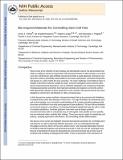Bioinspired Materials for Controlling Stem Cell Fate
Author(s)
Fisher, Omar Z; Khademhosseini, Ali; Langer, Robert; Peppas, Nicholas A
DownloadAccepted version (2.949Mb)
Terms of use
Metadata
Show full item recordAbstract
Although researchers currently have limited ability to mimic the natural stem cell microenvironment, recent work at the interface of stem biology and biomaterials science has demonstrated that control over stem cell behavior with artificial microenvironments is quite advanced. Embryonic and adult stem cells are potentially useful platforms for tissue regeneration, cell-based therapeutics, and diseasein-a-dish models for drug screening. The major challenge in this field is to reliably control stem cell behavior outside the body. Common biological control schemes often ignore physicochemical parameters that materials scientists and engineers commonly manipulate, such as substrate topography and mechanical and rheological properties. However, with appropriate attention to these parameters, researchers have designed novel synthetic microenvironments to control stem cell behavior in rather unnatural ways. In this Account we review synthetic microenvironments that aim to overcome the limitations of natural niches rather than to mimic them. A biomimetic stem cell control strategy is often limited by an incomplete understanding of the complex signaling pathways that drive stem cell behavior from early embryogenesis to late adulthood. The stem cell extracellular environment presents a miscellany of competing biological signals that keep the cell in a state of unstable equilibrium. Using synthetic polymers, researchers have designed synthetic microenvironments with an uncluttered array of cell signals, both specific and nonspecific, that are motivated by rather than modeled after biology. These have proven useful in maintaining cell potency, studying asymmetric cell division, and controlling cellular differentiation. We discuss recent research that highlights important biomaterials properties for controlling stem cell behavior, as well as advanced processes for selecting those materials, such as combinatorial and high-throughput screening. Much of this work has utilized micro- and nanoscale fabrication tools for controlling material properties and generating diversify in both two and three dimensions. Because of their ease of synthesis and similarity to biological soft matter, hydrogels have become a biomaterial of choice for generating 3D microenvironments. In presenting these efforts within the framework of synthetic biology, we anticipate that future researchers may exploit synthetic polymers to create microenvironments that control stem cell behavior in clinically relevant ways. (Figure Presented) © 2010 American Chemical Society.
Date issued
2010Department
Koch Institute for Integrative Cancer Research at MIT; Harvard University--MIT Division of Health Sciences and Technology; Massachusetts Institute of Technology. Department of Chemical EngineeringJournal
Accounts of Chemical Research
Publisher
American Chemical Society (ACS)
Citation
Fisher, O. Z., et al. "Bioinspired Materials for Controlling Stem Cell Fate." Accounts of Chemical Research 43 3 (2010): 419-28.
Version: Author's final manuscript